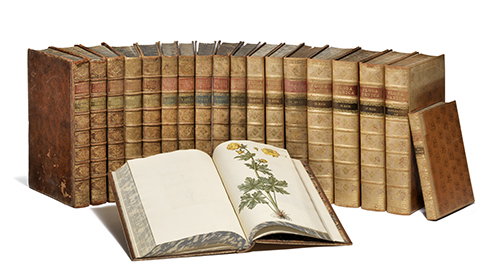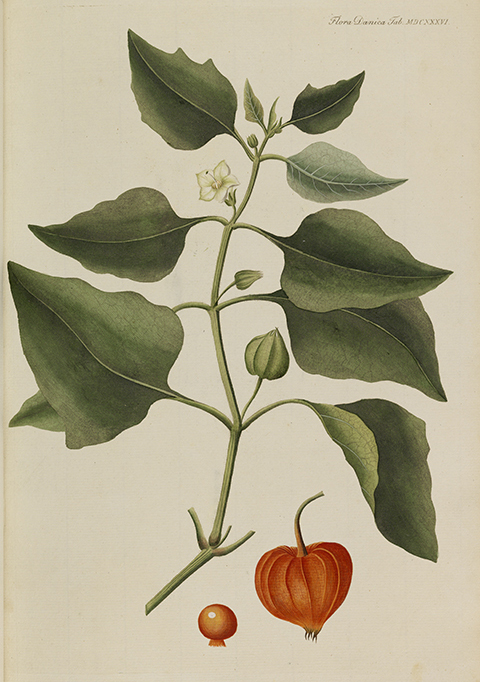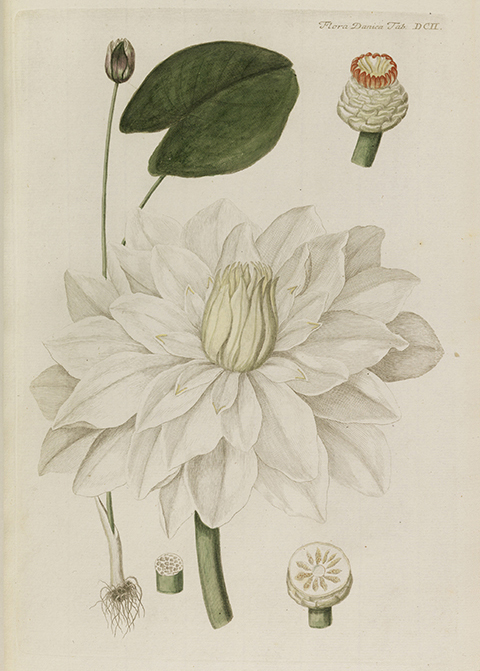Flora Danica – a World of Knowledge and Beauty
A (Delayed) Child of the Enlightenment
With its impressive 3240 plates published in booklets between 1761 and 1883, Flora Danica is not just the world's largest publication on flora, but also the work that has taken the longest to complete in the history of Denmark. The plan was initially that the project would take 10 years to finish. The idea arose at a time where all of Europe was focused on collecting and recording findings from the natural world, and thus the purpose of the project was entirely in the spirit of the Enlightenment. The goal was to expand the individual person's knowledge of plants and the many uses of them. At this time, the dependency on plants was still significant. Through a firmer knowledge of both the useful and harmful properties of the wild plants, the use of the local resources could be optimized, which in the end would benefit the country's overall economy. Flora Danica was published in "The Language of the Country, Danish and German", however, the work was also published in the scholarly language of the time, Latin, to attract an international audience.
The Country's Finest Botanists
It was the German-born G.F. Oeder, who was responsible for the publication of Flora Danica. Oeder was the first in a long line of editors-in-chief on the project and also Denmark's first professor of botany. Not long after he was appointed to his position in 1752, he began planning the publication project as well as the layout of a botanical garden at Amaliegade in Copenhagen. Both projects were intended to map out the Danish flora, which at that time included the flora of the duchies of Denmark, Norway, Iceland, the Faroe Islands and Greenland. After Oeder, nine different botanists headed up the work on the publication of the Flora Danica, including Theodor Holmskiold, the man who came up with the idea for the Flora Danica porcelain service – the magnificent hand-painted service decorated with pictures from the publication.
Scientists, Copper Printers and Illustrators in an Excellent Collaboration
Flora Danica was created in a collaboration between scientists, copper printers and illustrators. It was the publishers themselves who had to travel all over the country to gather information about the flora, and this work was not always easy. Just getting around Denmark at the time was highly strenuous, and if you were to visit Norway, the journey could mean a direct endangerment of your life. But additional help was eventually provided since the interest concerning the Flora Danica project continued to grow after the initial instalments had been published. More and more people submitted findings to the publishers or took part in the collection of plants. When a new plant had arrived, a watercolour was produced. The copper printers then incised the plates in accordance with the watercolour. After printing in black and white, the plates were hand-coloured with gouache that covered the black ink colour. Most of the copper plates from Flora Danica still exist and are located at the Natural History Museum of Denmark in Copenhagen. Some printing plates were lost after the fire of 1884 at Christiansborg Palace since the plates were stored in the attic of the palace. These have subsequently been reproduced.
A Precious Publication
Today, one does not really know how many complete copies exist of the Flora Danica. Outside Denmark, the work is known to exist in 13 copies. During his reign, the King ordered 55 copies to be made, which were distributed among bishops, prefects, selected scientific institutions, scientists, and the nobility. Today, complete copies of the botanical work are very rarely seen on the market.
Plates, Travel Journals and Letters
The auction also includes several rare topographical works and travel journals as well as original, handwritten greetings from Hans Christian Andersen. View all the lots of the book auction here.
Gallery Talk with Lærke Bøgh
During the preview for the auction at Bredgade 33 in Copenhagen, our specialist in books and manuscripts, Lærke Bøgh, will give a talk in Danish about the Flora Danica publication. This will take place on Friday 22 February at 2 pm. Everyone is welcome!
View all the lots of the book auction
Read more about the auction
Read about bidding at an auction
For further information, please contact:
Lærke Bøgh: +45 8818 1217 · lb@bruun-rasmussen.dk



